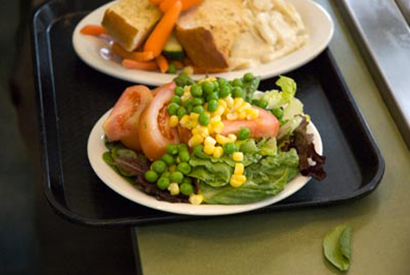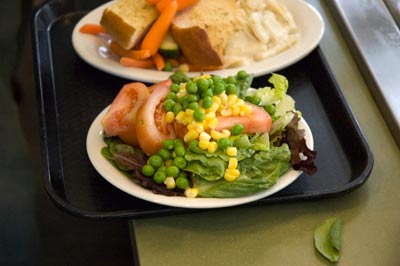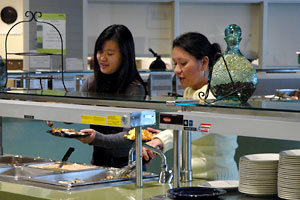Dining halls join the trayless trend
Trays in Berkeley's dining commons have gone the way of panty raids and letter sweaters — they're a thing of the past. As of the start of spring semester this week, Berkeley is joining the trend sweeping college campuses nationwide and eliminating most of the black plastic trays used in the Crossroads, Foothill, Clark Kerr, and Café 3 dining halls.

January 11, 2010
Trays in Berkeley’s dining commons have gone the way of panty raids and letter sweaters — they’re a thing of the past.

Out with plastic trays, in with trayless meals at four campus dining commons. (Steve McConnell/NewsCenter)
As of the start of spring semester this week, Berkeley is joining the trend sweeping college campuses nationwide and eliminating most of the black plastic trays used in the Crossroads, Foothill, Clark Kerr, and Café 3 dining halls.
A few trays remain in each hall for diners who really need them, such as those with mobility issues — and those adamantly opposed to going without, says Chuck Davies, Berkeley’s associate director for residential dining. But they’ll be in one central location in each hall, instead of stacked at each food line.
The student-inspired move is designed to increase the campus’s sustainability quotient by cutting down on food waste, garbage, and water and energy used to wash the trays. As a side benefit, it may also help students keep from overeating — or so the theory goes.
Anticipated savings
A test run of “trayless Fridays” in October in Crossroads and Clark Kerr showed that removing the trays reduced food waste by 16 percent, according to Sally Westcott, a second-year student and a leader in the campaign to go trayless.
“If you have a tray, you have endless possibilities — ‘I’m going to try this and this and this,’ more than you’re going to eat,” she explains. “If you have to travel back to get more food, you think about it more.”
Westcott, who is vice president of advocacy and outreach for the Residence Hall Assembly, sat at a table during “trayless Fridays,” drumming up support for the concept and conducting a survey of student attitudes. She found a majority to be positive, and gathered comments and some 300 signatures on a petition to banish trays.
Among the comments were “awesome!” and “carrying more plates is difficult but makes you get less food.”
But some students objected, including one who wrote: “We pay this much and we should get a tray.”

Students in Crossroads Dining Commons (Bonnie Azab Powell/NewsCenter)
“Most of the time when they listened — then they were really for it,” Westcott says.
The response from dining hall staff, who prepare, serve, and clean up after about 10,000 meals a day, has been very positive, too, according to Davies.
“They see it as a labor saver for them,” he says.
But there is one drawback, he adds: “Tables tend to be left more dirty. Students leave more dishes behind.”
Cost savings for the move have the potential to add up. Less food wasted means less food bought, prepared, and served, and less waste carted off to be composted, in addition to the water and power cost reductions.
Actual anticipated savings haven’t been calculated, but Davies says they would likely be used to pay for dining-program improvements. Berkeley’s dining is now 25 percent sustainable, Westcott says.
A national trend
Berkeley is now at least the fourth UC campus to take the trayless plunge, following Irvine, Riverside, and Santa Cruz. And UCLA has taken some steps in that direction.
The national trayless trend on college campuses has been picking up steam over the past two years, with encouragement from the large food-service companies that serve many of them. According to an article in the Los Angeles Times last fall, Aramark estimated that 60 percent of the 600 campuses it serves have gone trayless, and the other big vendor, Sodexo, said about 40 percent of its 600 have too.
“When the wave first hit the country, most universities going trayless were (served by) big food service companies, and we were suspicious of their motive,” Davies says. Berkeley bided its time, because “we wanted to be sure we were doing it for the right reasons — saving food, energy, and water.”
According to a New York Times survey of college campuses last spring, Williams College reported saving 14,000 gallons of water by cutting out trays, and the Rochester Institute of Technology estimated saving 10 percent on food spending.
Davies says that if removing trays provokes a huge backlash at Berkeley, “we can always bring them back.”